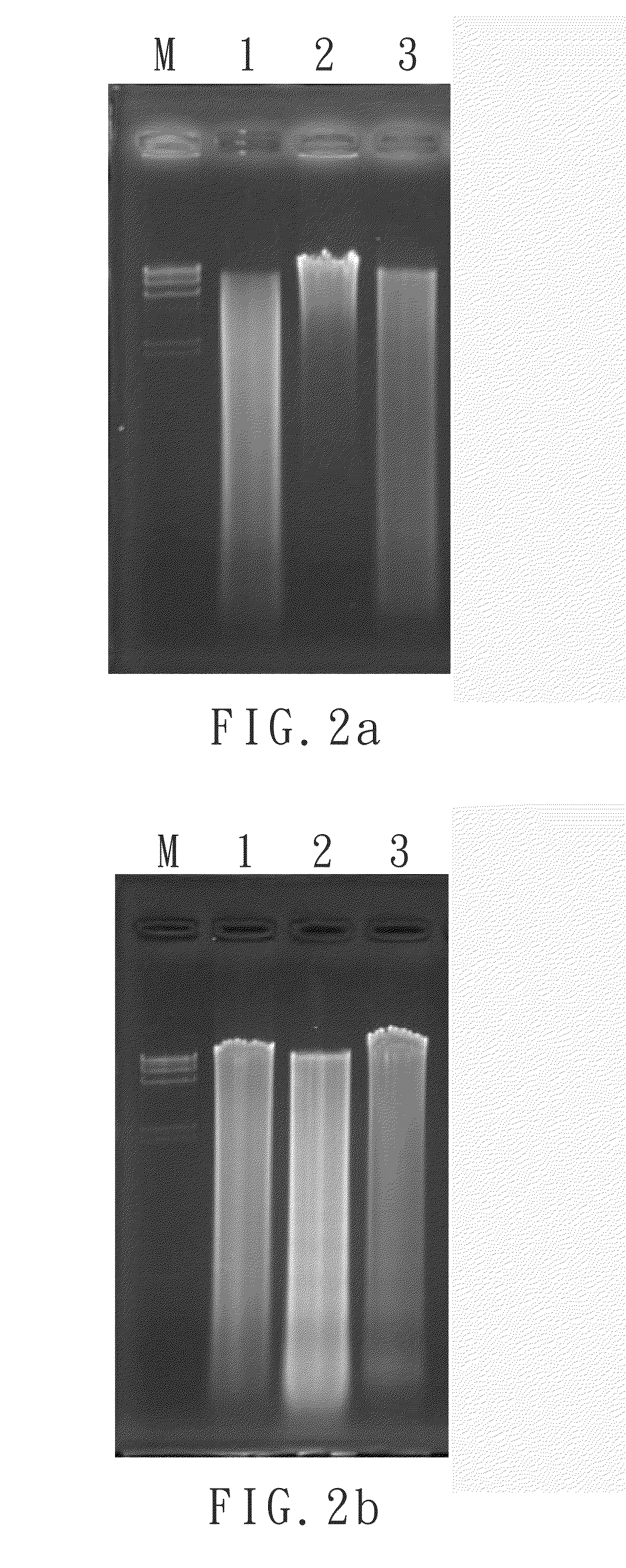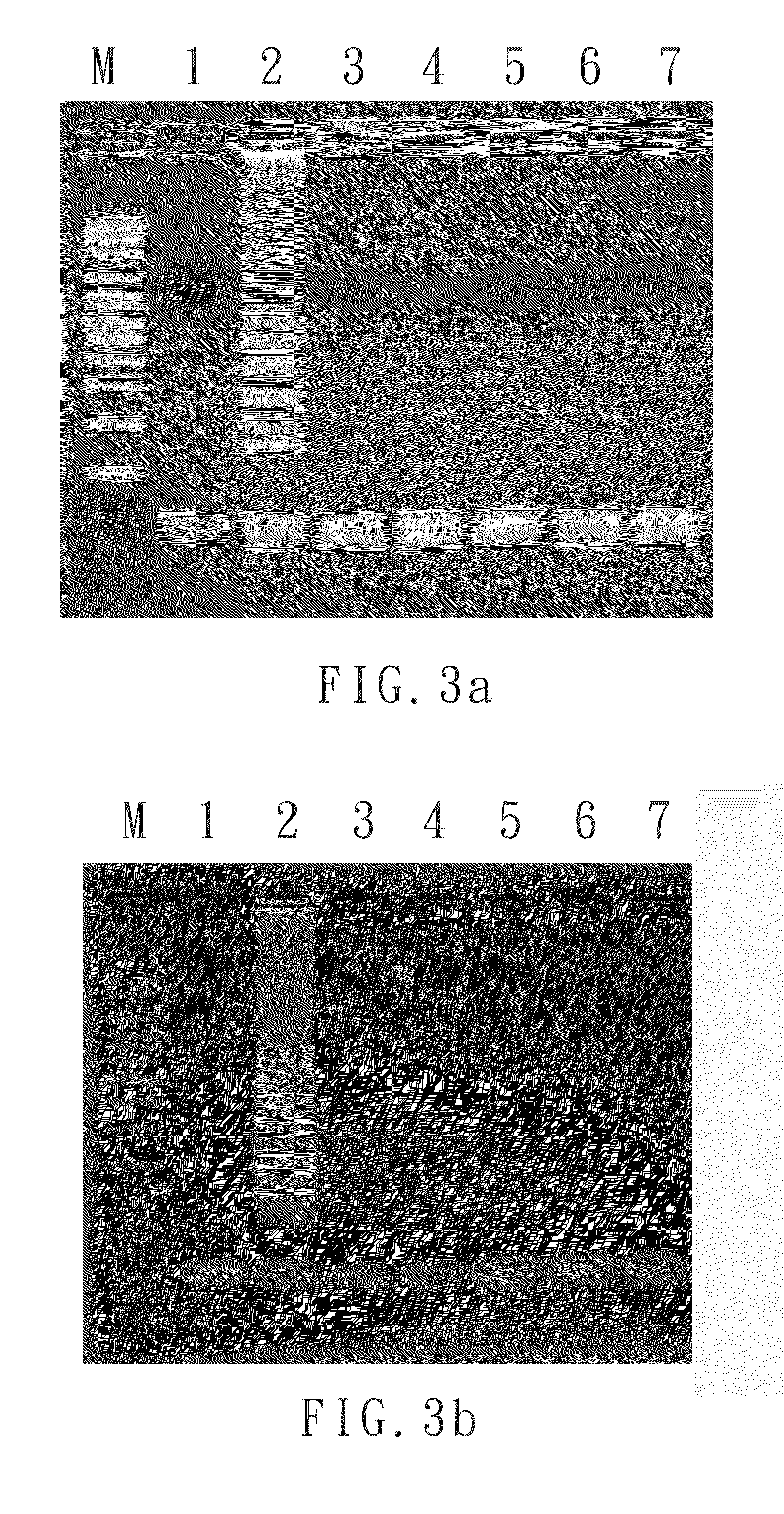Primer set and a method for identification of meat species
- Summary
- Abstract
- Description
- Claims
- Application Information
AI Technical Summary
Benefits of technology
Problems solved by technology
Method used
Image
Examples
first embodiment
[0053]The primer set according to the invention is designed according to a DNA sequence of GenBank database being mitochondrial cytochrome b of Bos indicus with a sequence number being GU256940. That is, the primer set is capable of amplifying a target fragment of mitochondrial cytochrome b of Bos indicus. The forward outer primer 11, with length being 23 bases, corresponds to a sense strand of DNA fragment of mitochondrial cytochrome b of Bos indicus between positions 303 and 325. The backward outer primer 12, with length being 18 bases, corresponds to an antisense strand of DNA fragment of mitochondrial cytochrome b of Bos indicus between positions 490 and 507. The first annealing portion 211, with length being 25 bases, corresponds to a sense strand of DNA fragment of mitochondrial cytochrome b of Bos indicus between positions 336 and 360, while the first warped portion 212, with length being 25 bases, corresponds to an antisense strand of DNA fragment of mitochondrial cytochrome...
second embodiment
[0054]The primer set according to the invention is designed according to a DNA sequence of GenBank database being mitochondrial cytochrome b of Gallus gallus with a sequence number being AF119093. That is, the primer set is capable of amplifying a target fragment of mitochondrial cytochrome b of Gallus gallus. The forward outer primer 11, with length being 19 bases, corresponds to a sense strand of DNA fragment of mitochondrial cytochrome b of Gallus gallus between positions 70 and 88. The backward outer primer 12, with length being 19 bases, corresponds to an antisense strand of DNA fragment of mitochondrial cytochrome b of Gallus gallus between positions 241 and 259. The first annealing portion 211, with length being 20 bases, corresponds to a sense strand of DNA fragment of mitochondrial cytochrome b of Gallus gallus between positions 100 and 119, while the first warped portion 212, with length being 21 bases, corresponds to an antisense strand of DNA fragment of mitochondrial cy...
third embodiment
[0055]The primer set according to the invention is designed according to a DNA sequence of GenBank database being mitochondrial cytochrome b of Sus scrofa with sequence number being GU211931. That is, the primer set is capable of amplifying a target fragment of mitochondrial cytochrome b of Sus scrofa. The forward outer primer 11, with length being 18 bases, corresponds to a sense strand of DNA fragment of mitochondrial cytochrome b of Sus scrofa between positions 51 and 68. The backward outer primer 12, with length being 21 bases, corresponds to an antisense strand of DNA fragment of mitochondrial cytochrome b of Sus scrofa between positions 235 and 255. The first annealing portion 211, with length being 24 bases, corresponds to a sense strand of DNA fragment of mitochondrial cytochrome b of Sus scrofa between positions 74 and 97, while the first warped portion 212, with length being 25 bases, corresponds to an antisense strand of DNA fragment of mitochondrial cytochrome b of Sus s...
PUM
| Property | Measurement | Unit |
|---|---|---|
| Temperature | aaaaa | aaaaa |
| Time | aaaaa | aaaaa |
| Mass | aaaaa | aaaaa |
Abstract
Description
Claims
Application Information
 Login to View More
Login to View More - R&D
- Intellectual Property
- Life Sciences
- Materials
- Tech Scout
- Unparalleled Data Quality
- Higher Quality Content
- 60% Fewer Hallucinations
Browse by: Latest US Patents, China's latest patents, Technical Efficacy Thesaurus, Application Domain, Technology Topic, Popular Technical Reports.
© 2025 PatSnap. All rights reserved.Legal|Privacy policy|Modern Slavery Act Transparency Statement|Sitemap|About US| Contact US: help@patsnap.com



